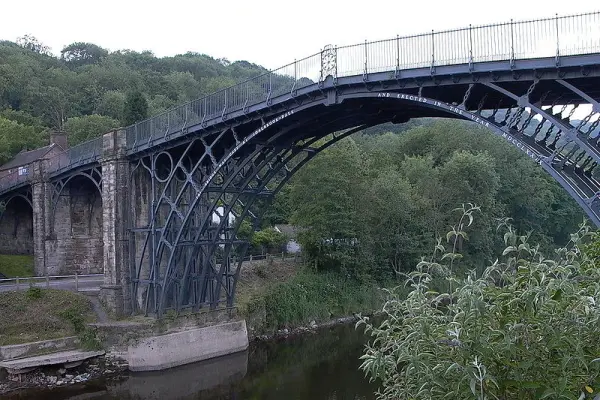Origins of the Industrial Revolution in Construction
"The Industrial Revolution not only transformed production methods but also gave rise to an entirely new architectural typology that shaped the appearance of cities for centuries to come."
A historically significant event that took place in Western Europe from the late 18th to early 19th centuries was the industrial boom. This event had a profound impact on economic and cultural development, as well as progress in the field of architecture. The foundation of this boom was the shift from manual labor to machine-based production.
With this change came the need for new types of buildings, such as factories and mills, which led to significant transformations in architecture and construction. These changes were a response to new production requirements: the need to accommodate large equipment, ensure good lighting and ventilation, and create efficient workspaces.
Revolution in Construction Materials
In the field of metallurgy, the range of cast iron and steel products expanded significantly, opening new horizons for architectural design. When designing factories and mills, architects were tasked with creating efficiently functioning buildings quickly and economically, where aesthetic considerations were subordinate to practicality and cost-effectiveness.
Reflections on the importance of using non-combustible construction materials in structures led to the widespread use of brick for walls and the introduction of new metallic elements for floor structures, such as metal beams with protruding flanges on which brick vaults were laid, with cast iron columns used as supports.
The standardization of column and beam sizes facilitated faster construction, which was critically important during the period of rapid industrial growth. Advances in metalworking and metallurgy provided builders with new materials that also found applications in the construction of bridges, viaducts, and other complex engineering structures.
Revolution in Bridge Construction

"The Coalbrookdale Bridge marked a turning point in the history of construction. It demonstrated that metal could be not only strong but also aesthetically expressive as a building material."
By the late 18th and early 19th centuries, bridges of significant length began to be constructed, the first of which were made from cast iron elements. An example is the Coalbrookdale Bridge, with a 30-meter span and an elegant metal structure. Progress in bridge construction advanced rapidly, and by the early 19th century, various bridge designs for large spans had been developed.
Development of Commercial Architecture

The development of capitalism spurred the construction of large commercial buildings requiring wide spans and maximum lighting. Lightweight metal structures began to be used for these buildings, such as for the platforms of railway stations. Architects gradually moved away from traditional forms, and by the second half of the 19th century, buildings with metal load-bearing structures openly showcasing their technical features appeared in England and France.

Triumph of Engineering: Achievements of the 1889 International Exhibition
Two structures from the 1889 International Exhibition in Paris were particularly significant: Gustave Eiffel’s 300-meter tower and the "Machine Gallery," a massive metal structure. These structures showcased the potential of metal constructions to the world and became symbols of a new era in construction.

Development and Application of Reinforced Concrete
"The invention of reinforced concrete brought about a true revolution in construction, comparable in significance to the discovery of metal structures. This material combined the strength of metal with the plasticity of stone."
In the mid-19th century, reinforced concrete was invented, becoming a new construction material that gained theoretical and practical development through the work of engineer Hennebique. In Russia, metal structures were also actively used, for example, in the construction of the dome of Kazan Cathedral and the metal roofing of a shipyard slipway in St. Petersburg.

In the following decade, reinforced concrete saw further development in both structural and theoretical terms. Engineer Hennebique made significant contributions to the theory and practice of using this material, developing a reinforcement system designed to withstand tensile and shear loads. Today, the evolution of these principles has led to the creation of modern self-healing concretes, which can automatically repair microcracks and significantly extend the lifespan of structures.

Legacy of the Industrial Revolution in Construction
The engineering and technical achievements of the 19th century in construction not only facilitated the development of new types of buildings and structures but also laid the foundation for future innovations in architecture and construction. Metal structures and reinforced concrete, first used in industrial buildings, became the basis for 20th-century modernist architecture, which completely rethought design principles and openly showcased structural solutions as an aesthetic element.
| Period | Material | Structural Features | Examples of Structures |
|---|---|---|---|
| Late 18th century | Cast Iron | Metal beams with protruding flanges, cast iron columns | Coalbrookdale Bridge |
| Early 19th century | Metal and Brick | Brick vaults on metal beams | Factory buildings |
| Mid-19th century | Reinforced Concrete | Hennebique’s reinforcement system | Industrial structures |
| Late 19th century | Steel | Metal load-bearing structures | Eiffel Tower, Machine Gallery |
This table illustrates the evolution of construction technologies throughout the 19th century, reflecting the gradual development and improvement of structural solutions.
Technical Features of New Structures
- Use of metal beams with protruding flanges for floor structures
- Employment of cast iron columns as supporting elements
- Combination of metal structures with brick vaults
- Standardization of structural element sizes
- Development of reinforced concrete reinforcement systems
These technical solutions became the foundation for the development of modern construction technologies and continue to be used in modified forms to this day.

